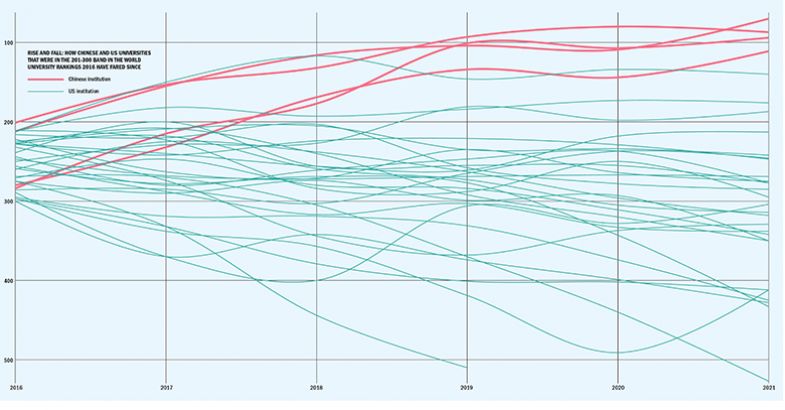Browse the full results of the World University Rankings 2021
Although the rise of Chinese universities over the past 10 years has been well documented, it is sometimes not obvious that a major global shift is taking place, given that US universities still dominate the highest placings of the World University Rankings.
Apart from two universities from the UK, the US fills the top 10, its eight entries led by Stanford University in second place. It is not until 20th place that a Chinese university (Tsinghua University) enters the fray.
However, look further down the rankings and a significant pattern of change between the two global higher education powerhouses emerges.
Chinese universities that occupied positions between 201 and 300 in 2016 have all now broken into, or seem on the verge of breaking into, the top 100, including Fudan University (in joint 70th place in the 2021 ranking), the University of Science and Technology of China (joint 87th), Zhejiang University (joint 94th) and Nanjing University (joint 111th).
And although the US had many more universities in the 201-300 band in 2016, and a few have climbed since then (such as Indiana University and Northeastern University), none has made it to the top 100 and several have drifted downwards.
Those that have lost ground include Rensselaer Polytechnic Institute (now in the 501-600 band), Iowa and Oregon state universities (401-500) and Stony Brook University (301-350).
It is worth noting that the US still has many more universities in the top 200 – 59 in total compared with just seven from China. And across the whole ranking there are 181 US institutions, about double those that can be found in mainland China (91).
But the trend of the past few years – of a growing number of top Chinese institutions starting to compete at the highest level – raises major questions about what the global landscape of research-intensive universities may look like in the coming years.
simon.baker@timeshighereducation.com
How Chinese and US universities that were in the 201-300 band in the World University Rankings 2016 have fared since
(Click for larger image)
Register to continue
Why register?
- Registration is free and only takes a moment
- Once registered, you can read 3 articles a month
- Sign up for our newsletter
Subscribe
Or subscribe for unlimited access to:
- Unlimited access to news, views, insights & reviews
- Digital editions
- Digital access to THE’s university and college rankings analysis
Already registered or a current subscriber? Login









